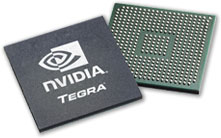NVidia Tegra 2 is currently one of the most powerful processor used in smartphones and tablets such as the upcoming LG Optimus 2X smartphone or the new version of Samsung Galaxy Tab.
NVidia describes the processor as follows:
NVIDIA® Tegra™ 2 is the world’s most advanced mobile processor, featuring the world’s first mobile dual-core CPU for up to 2x faster Web browsing; the world’s only ultra-low power (ULP) NVIDIA® GeForce® GPU for up to 5x faster gaming; and the world’s first mobile 1080p HD video processor for flawless HD video conferencing and playback. Get never-before-seen experiences on a mobile device with NVIDIA Tegra.
NVidia Tegra 2 is based on a dual core Cortex A9 running up to 1GHz, supports 32-bit DDR2 RAM and features NVidia Geforce GPU with OpenGL ES 2.0 support.
Contrary to many other companies finding the development kit, documentations and tools is straightforward. Once you get to the NVIDIA Tegra 2 Page, click on Developper Zone and download the supported operating systems:
| OS Image (for NVIDIA development hardware ONLY) | Host Platform | Last update | Size | Link |
| Android 2.2 (Froyo) | Windows XP/Vista/7 | 11/11/10 | 478kB 71.1MB |
PDF MSI |
| Android 2.2 (Froyo) | Linux | 11/11/10 | 478kB 63.4MB |
PDF RUN |
| Linux For Tegra (L4T) Release (kernel 2.6.32; git tag tegra-10.9.3) | Linux | 10/29/10 | 1,082kB 121.9MB |
PDF RUN |
| Linux For Tegra (L4T) Release (kernel 2.6.32; git tag tegra-10.8.2) | Linux | 09/03/10 | 1,050kB 124.6MB |
PDF RUN |
| Linux For Tegra (L4T) Release (kernel 2.6.32; git tag tegra-10.7.2) | Linux | 08/10/10 | 1,052kB 126.5MB |
PDF RUN |
| Unofficial Linux Support (Ubuntu, Gentoo, Fedora etc) | Linux | Ongoing | N/A | URL |
| Windows CE 6* | Windows XP/Vista/7 | 02/01/10 | 1.02MB 34.1MB |
PDF MSI |
The development documents and guides:
| Title | Target OS | Last update | Size | Link |
| Tegra Android Setup Guide | Android | 11/20/10 | 1.2MB | |
| Tegra Hardware Introduction & Detailed Setup Guide | All | 02/01/10 | 1.9MB | |
| Android Upcoming Device Preparation Guide | Android | 10/29/10 | N/A | URL |
| Android Accelerometer Whitepaper | Android | 11/11/10 | 983kB | |
| Developing shader-based OpenGL ES 2.0 applications on the Tegra platform: An OS-independent tutorial providing details of the capabilities of the Tegra OpenGL ES 2.0 hardware and driver. | All | 02/01/10 | 516kB | |
| GameSauce 2010 slides and audio recordings. Speakers from NVIDIA, Adobe, China Mobile, Stonetrip, Allegorithmic and Unity. | All | 08/13/10 | N/A | URL |
| GDC 2010 Tegra presentation “Developing Killer Content For Advanced Mobile Platforms | All | 04/01/10 | N/A | URL |
Some sample code:
| Title | Target OS | Last update | Size | Link |
| Android NDK sample applications and documentation (NV_EVENT, accelerometer, audio, JNI performance, OpenGL ES 2.0 and multitouch) | Android | 11/24/10 | 10.6MB | ZIP |
| Windows CE 6 OpenGL ES 2.0 sample applications | Windows CE | 01/15/10 | 285kB | ZIP |
| Tegra Khronos Application SDK for Windows CE 6 with Windows XP/Vista/7 OpenGL ES 2.0 emulator | Windows CE | 03/12/10 | 643kB 55.8MB |
PDF MSI |
and the development tools:
| Title | Target OS | Last update | Size | Link |
| NVIDIA PerfHUD ES rendering analysis tool documentation & host machine installers | Android, Linux | 08/10/10 | N/A 845.7kB 12.5MB 1.7MB 1.7MB 9.5MB |
Info URL Windows Linux 32bit Linux 64bit Mac |
| NVIDIA Debug Manager for debugging Android NDK applications in Eclipse (supports NDK r4b; NDK r5 support coming soon) | Android | 12/17/10 | 5.0MB 860kB |
ZIP |
| GDB debugging guide for setting up and debugging Android NDK based applications from within Eclipse | Android | 10/11/10 | 6.2MB | ZIP |
| Setup files and guide to profiling and application analysis with oprofile | Android | 05/02/10 | 44.6MB | ZIP |
| x86 Windows OpenGL ES 2.0 Emulator | Windows XP/Vista/7 | 15/01/10 | 478kB 4.3MB |
PDF MSI |
If you want to follow any updates for the OS, documents and SDK, I recommend you follow NVidia on twitter @ http://twitter.com/nvidiadeveloper although you’ll also receive updates for all their PC graphics card as well.
If you have any questions you can also visit the Tegra Forum which is relatively active.
If you need Tegra hardware for development, you’ll need to register with NVidia and they’ll reply within 7 to 10 days so that you can get the reference design for 399 USD. This is apparently only available for developers in the US and Canada.
For more detailed information check out NVidia Tegra 250 Developer Kit Hardware Introduction and Setup PDF.
Once retail products hit the market, you might just buy one of the phones or tablets to develop on it and I’m sure xda-developers will also take care of tuning and adding features to those devices.

Jean-Luc started CNX Software in 2010 as a part-time endeavor, before quitting his job as a software engineering manager, and starting to write daily news, and reviews full time later in 2011.
Support CNX Software! Donate via cryptocurrencies, become a Patron on Patreon, or purchase goods on Amazon or Aliexpress





